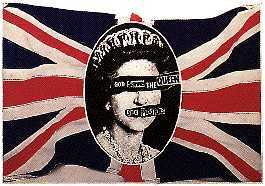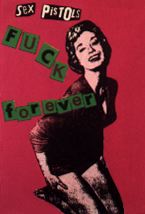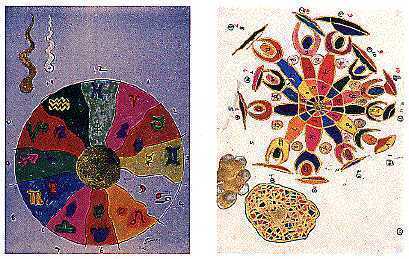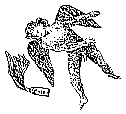                |
|
Up
they rise |
|
|
|

|
|
The Printed World |
Revulsion
was the authorized social response to Jamie
Reid's graphics for the Sex Pistols. The
most potent visible manifestation of disquiet
during the 1977 Royal Jubilee celebrations
was a photograph of the Queen - defaced by
blackmail-style lettering and a safety pin
through the lip - reproduced on the posters,
ads and sleeves for the Sex Pistols single "God
Save The Queen". |
| |
 |
 |
Using
the agitprop style he had perfected years
earlier in the suburban resistance, Reid
was speaking to and for a generation which
responded to the Sex Pistols cry by making
it the top-selling record in Jubilee week.
Banning it from the airwaves only confirmed
that here was another Britain, one whose existence
was too uncomfortable to be acknowledged. The
record sleeve was more of a shriek than a picture:
could this rough-and-ready display (hardly
Artwork, surely?), this remaking of the
ready-made, be taken seriously as a form of
packaging design? It was because it could not
that it spoke to so many people who were surrounded
by soothing voices when all they wanted to
do was scream.
Not that Jamie is sure of himself. Punk catalyst McLaren already
had many of the answers when he sent his mobilization
signal to Reid; what he needed from Jamie was
his talent for posing the questions.
Punk was soon taken seriously when the marketing
men in the media and the music business saw
its strength of identification, although Jamie
remained continually at war with industry bosses.
To the consternation of authorities at home,
college and town hall, the icons of punk exploded
on a thousand leather jackets in a thousand
different towns, and started leading their
own lives. What they were mainly saying was, DO
IT, GO ON, SAY IT, ASK. And furthermore, we
don't like what you're doing to us, why are
you ramming this down our throats?
Jamie Reid's work also did something else.
It demonstrated the power of craphic design
in the music industry and opened the door to
a strong new generation of British designers,
whose purpose was different from Jamie's. They
used the creative freedom of the music industry
as a showcase for vibrant design, not emasculated
by corporate compromise. Their influence has
spread beyond music to fashion, the media and
consumer packaging. |
| |
Politically,
punk proved a mere hiccup in the right-wing
revolution just getting underway - but ten
years after its coronation the tide looks
like turning again. People are getting impatient
with police chiefs telling them that their
children are swirling in a cesspit of their
own making. They don't want papers screaming
that junkies are evil (exclusive pictures,
centre pages) when their brothers and
sisters are frightened victims. They are
wise to governments maintaining that all
is safely under control and the details are
best kept secret.
Power depends on controlling information. Public
pressure for greater access as technology takes
root has been met by increasingly sophisticated
attempts to massage public opinion and, failing
that, to intimidate public servants and the
media into keeping stumm. But we are moving
into real time once more and the control of
information will inevitably erode. |
|

(Astrological Clocks. Jamie
Reid.
Working prints and collage 297 x 210 mm - 1989) |
| |
|
| |
Again Jamie Reid
is at the sharp end of the wedge. There is
now much greater emphasis in his work on
canvases, some of which he has been working
on for twenty years. While punk was going
through the whole marketing spectrum from A to E and
back again, he remained larcely aloof from
the commecial world, venturing out only briefly
with his poster and titles for Letter
to Brezhnev, on which he worked with
Frank and Margi Clarke.
He is still not offering answers but his more
spiritual expression is tuned to the last decade
of the century. In the 1970s the vehicle was
the Sex Pistols and Jamie could hide behind
his craphics. But the slogan he devised for
one poster "Anyone Can Be A Sex Pistol",
also meant for him that the next stace was
more of a direct-input assertion. "I love
painting the most," he says. "You
are completely naked. Paintings are for life." New
visuals and paintings are proliferating for Leaving
the Twentieth Century - his creative
collaboration with Margi Clarke who says "the
only time I am ever afraid of Jamie is when
he's painting purple thunder on his face and
chewing the paintbrushes." |
|

LISTEN TO:
'CHAOS IN CANCERLAND'
DEMO 1981
Real audio 5.0
|
|
| |
Art critics have
mostly been dubious about parking their cars
near Jamie's exhibitions and the art world
has trouble defining what if anything he
is. Eyebrows have been raised by his references
to Pollock and Hogarth and questions asked
about his credentials as a fine artist. But
the questions Jamie Reid asks are about power
humanity and media sickness in the technological
world. Everything can be copied changed printed
kept; anyone can have access and input. "Real" art
has followed power from the churches and
the courts to the salons and from there into
galleries and banks. Tomorrow it will also
be in supermarkets and millions of private
homes giving a human language to those who
have power at their fingertips. |
|

|
|
| |
Jamie has spent
six solid months compiling this book which
he says "contains all the important
images I have come up with in the past twenty-five
years". It became another total immersion
project for him because it closes a chapter
of his past and points a way to the future. |
|

|
| |
Kasper de Graaf
Assorted iMaGes, London
from:
JAMIE REID
UP THEY RISE : THE INCOMPLETE WORKS OF JAMIE REID
First published in 1987 by FABER & FABER Limited.
ISBN 0-571-14762-3
Text: ©1987, Jamie Reid and Jon Savage.
Illustrations: ©1987, Jamie Reid. |
| |
more incomplete works...

|
|
|
|































